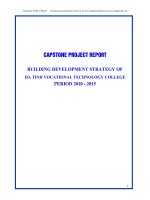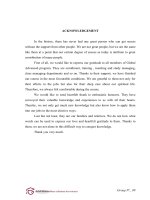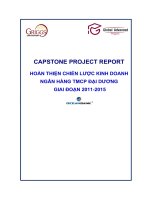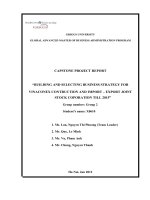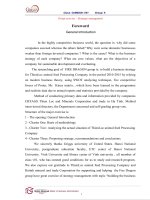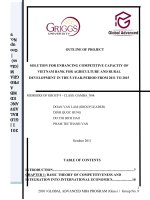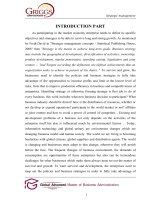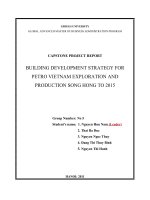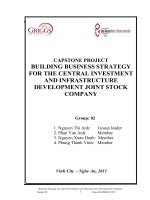Luận văn thạc sĩ quản trị kinh doanh quốc tế MBA (11)
Bạn đang xem bản rút gọn của tài liệu. Xem và tải ngay bản đầy đủ của tài liệu tại đây (829.64 KB, 108 trang )
GRIGGS UNIVERSITY
GLOBAL ADVANCED MASTER OF BUSINESS ADMINISTRATION PROGRAM
CAPSTONE PROJECT REPORT
“BUILDING AND SELECTING BUSINESS STRATEGY FOR
VINACONEX CONTRUCTION AND IMPORT – EXPORT JOINT
STOCK COPORATION TILL 2015”
Group number: Group 2
Student’s name: X0610
1. Ms. Lan, Nguyen Thi Phuong (Team Leader)
2. Mr. Quy, Le Minh
3. Mr. Vu, Pham Anh
4. Mr. Chung, Nguyen Thanh
Ha Noi, Jan 2012
ACKNOWLEDGEMENT
Firstly, we would like to express our great appreciations to lecturers, professors,
doctorsand doctors at Centre for Educational Technology and Career
Development – Vietnam National University and Griggs University who have
brought helpful and interesting courses to all program attendants, especially
those who have enthusiatically supported us in the completion of this
assignment.
During the performance of this assignment, we could have made some inevitable
mistakes and we do hope to receive your kind supportive opinion in order to
make the assignment of Team No.2 be more corrective and completed.
Throughout the execution of this assignment as well as discussions, we have
received kind supports from lectures, especially, Professor Ph.D Vu Thanh Hung
who has enthusiasticallyenthusiastically provided helpful ideas to support our
team to complete our assignment. We also express our appreciation to leaders of
VINACONEX Corporation who have supported us to access the firm’s data and
information and provided us with references so that we can complete our
assignment.
Members of Team No.2 - GaMBA X06.10
Hanoi, Nov 22nd 2011
Group Leader
LAN, NGUYEN THI PHUONG
Capstone Project Report
Gamba01.X0610 - Group 2
2
TABLE OF CONTENTS
ACKNOWLEDGEMENT........................................................................................
2
GENERAL INTRODUCTION.................................................................................
6
1. Reason for selecting the topic and the meaning of research topic.........................
6
2. Objectives and Scope of the research.....................................................................
6
3. Research Methodology...........................................................................................
7
4. Structure of topic....................................................................................................
8
CHAPTER I: GENERAL RETIONALE FOR BUSINESS STRATEGY
DEVELOPMENT......................................................................................................
9
1.1 Overview of Business Strategy............................................................................
9
1.1.1 The concept of business strategy
..........................................................................................................................
9
1.1.2 Characteristics of business stratergy
..........................................................................................................................
10
1.1.3 The role of business strategy
..........................................................................................................................
10
Capstone Project Report
Gamba01.X0610 - Group 2
3
1.2 Strategy development process............................................................................
11
1.2.1 Organization’s missions and goals identification
..........................................................................................................................
11
1.2.2 External Factor Evaluation
..........................................................................................................................
12
1.2.2.1General factors (PEST)
...............................................................................................................
12
1.2.2.2 Industry factors
...............................................................................................................
15
1.2.2.3 External Factor Evaluation
...............................................................................................................
16
1.2.3 Internal Factor Evaluation
..........................................................................................................................
18
1.2.3.1 ResourceResour Analysis
..........................................................................................................................
18
1.2.3.2 Value chain Analysis
..........................................................................................................................
19
1.2.3.3 Corporation Culture And and Reputation Analysis
..........................................................................................................................
20
1.2.3.4 Internal Factor Evaluation
..........................................................................................................................
20
1.2.3.5 SWOT matrix
Capstone Project Report
Gamba01.X0610 - Group 2
4
..........................................................................................................................
22
1.2.4 Support1.2.4 Support tools for strategy selection
..........................................................................................................................
22
1.2.4.1 SPACE
..........................................................................................................................
23
1.2.4.2 BCG
..........................................................................................................................
23
1.2.4.3 TOWS
..........................................................................................................................
25
1.2.4.4 QSPM
..........................................................................................................................
26
CHAPTER II: ANALYSIS OF VINACONEX CORPORATION’S BUSINESS
SITUATION IN RECENT YEARS..........................................................................
28
2.1 Corporation Overview.........................................................................................
28
2.1.1History and development
..........................................................................................................................
28
2.1.2 Organizational structure
..........................................................................................................................
29
2.1.3 Achievements and problems
..........................................................................................................................
30
2.2Analysis of current business strategy development at VINACONEX..............
31
Capstone Project Report
Gamba01.X0610 - Group 2
5
2.2.1 The fundamental basis for business strategy development
..........................................................................................................................
31
2.2.1.1 Define the demand for strategy developement
..........................................................................................................................
32
2.2.1.2 The basis for strategy development
..........................................................................................................................
32
2.2.2 External Factor Evaluation
..........................................................................................................................
32
2.2.2.1PEST Analysis
..........................................................................................................................
32
2.2.2.2 Industry factors
..........................................................................................................................
36
2.2.2.3 External Factor Evaluation (EFE) Matrix
..........................................................................................................................
42
2.2.3 Internal Factor Evaluation
..........................................................................................................................
43
2.2.3.1Value chain Analysis
..........................................................................................................................
43
2.2.3.2 Financial Analysis
..........................................................................................................................
46
2.2.3.3Corporation Culture and Reputation Analysis
..........................................................................................................................
50
2.2.3.4 Internal Factor Evaluation (IFE) Matrix
Capstone Project Report
Gamba01.X0610 - Group 2
6
..........................................................................................................................
50
2.3 Strategic planning tools.......................................................................................
52
2.3.1 BCG Matrix
..........................................................................................................................
52
2.3.2 SWOT matrix for construction products
..........................................................................................................................
53
2.3.2.1 Strengths
..........................................................................................................................
53
2.3.2.2 Weaknesses
..........................................................................................................................
53
2.3.2.3 Opportunities
..........................................................................................................................
53
2.3.2.4 Threats
..........................................................................................................................
53
2.4 A2.4 A few comments on the Corporation's business and production............
57
2.4.1 Achievements
..........................................................................................................................
57
2.4.2 Problems and the causes
..........................................................................................................................
57
CHAPTER III: BUSINESS STRATEGY VINACONEX CORPORATION TILL
2015 AND SOLUTIONS FOR IMPLEMENTATION...............................................
59
Capstone Project Report
Gamba01.X0610 - Group 2
7
3.1 Recognizing the industrial trends toward 2015.................................................
59
3.2 VINACONEX Corporation’s Business Strategy development and selection. .
64
3.3 Strategy implementation methods......................................................................
73
3.4 Recommendations and proposals.......................................................................
74
CONCLUSION AND PROPOSAL..........................................................................
77
REFERENCE.............................................................................................................
79
Capstone Project Report
Gamba01.X0610 - Group 2
8
GENERAL INTRODUCTION
1. Reason for selecting the topic and the meaning of research topic
At present, in the context of extreme competitiveness happening in every aspect
of business and the severe crisis on financial and monetary market, in order for
a firm to survive and grow, the most important and necessary task is to drive the
firm toward the right direction that suits to fluent and sudden changes in
business environment so as to obtain high level of adaption and to ensure the
sustainable development for the firm. To achieve that goal, every firm has to
determine and develop nothing but its own suitable business strategy. It’s all
because business strategy means the foundation, the compass for every activity
of that firm.
Hence, this is the common and main issue of firms, including those engages in
construction sector – the sector that is growing rapidly in accordance with
consuming trend, the sector that satisfiessastisfies one of the three fundamental
needs of human which are food, shelter and entertainment. Each firm needs to
develop a sound business strategy which is appropriate with continuously
changing high competitive environment and at the same time suitable with its
own condition and situation. This is the motivation for our research on the topic
“Business strategy development at Vietnam Construction and Import-Export
Joint Stock Corporation (VINACONEX Corporation) in the period 2012-2015”
in order to figure out the right direction for the firm in present context.
2. Objectives and Scope of the research
In this research, we - a team of class X0610 (Team No.2) – are comprised of
following members:
-
Lan, Nguyen Thi Phuong
Capstone Project Report
Gamba01.X0610 - Group 2
9
-
Quy, Le Minh
-
Vu, Pham Anh
-
Chung, Nguyen Thanh
On the basis of business environment analysis, the team appliesapply the two
models: BCG and SWOT in developing business strategy for VINACONEX for
the next period.
VINACONEX comprises one wholly owned company, 35 subsidiaries with
joined capital from 50% and above, 3 joint ventures, 17 associated companies.
The Corporation also invested capital into 19 other companies. In the scope of
this assignment, our team focus on analyzing the business of Vietnam
Construction and Import – Export Joint Stock Corporation - VINACONEX and
its real estate business
VINACONEX hiện có 01 Cơng ty 100% vốn, 35 cơng ty con có vốn góp trên 50%
của Tổng công ty, 3 công ty liên doanh, 17 công ty liên kết, ngồi ra góp vốn tại
19 đơn vị khác. Vì vậy, trong đề tài này nhóm chúng tơi tập trung phân tích hoạt
động kinh doanh của Tổng Cơng ty cổ phần xuất nhập khẩu và xây dựng
Vinaconex và lĩnh vực hoạt động kinh doanh bất động sản.
At present, the operation of real estate business meets plenty of difficulties.
DespiteInspite of being a big company, the company has still made some wrong
moves that were not appropriate with the company’s real capacity. Attending the
program has provided our team with important supplementary knowledge so
that we have tools to analyze and to evaluate the presenting situation of
VINACONEX in order to obtain solutions to develop strategy that suits the real
estate operating market which is sinking into crisis so as for VINACONEX to
grow stably in new period.
To develop the business strategy, our team has made analysis based on following
basic issues:
-
Analysis of present real estate market;
Capstone Project Report
Gamba01.X0610 - Group 2
10
-
Analysis of the actual fact of VINACONEX’s strategy development
activities;
-
Analysis of External environment
-
Assessment on Strength, Weakness, Opportunities, Threats from business
environment
-
Developing an appropriate business strategy for VINACONEX in the period
of 2011-2015 on the basis of minimizing the weakness and improving the
strength in order to enhanceinhance the recent achieved results and keep on
developing continuously and sustainably.
3. Research Methodology
SWOT analysis: is the key method in strategic management used to evaluate the
internal factors: Strength, weaknesses of enterprises as well as the external
factors: Opportunities, Threats that make great impacts to the business of
enterprises.
Besides, there are also different types of matrix used as analysis methods such
as: BCG matrix, IFE matrix, EFE matrix…. These analysis methods will be
presented in Theory for strategic management
4. Structure of topic
Charpter I: GENERAL RATIONALE FOR BUSINESS STRATEGY DEVELOPMENT
Charpter II: ANALYSIS OF THE ACTUAL SITUATION OF VINACONEX
CORPORATION’S BUSSINESS IN RECENT YEARS
Charpter III: DEVELOPING BUSINESS STRATEGY FOR VINACONEX
CORPORATION FOR THE PERIOD 2012-2015
Capstone Project Report
Gamba01.X0610 - Group 2
11
CHAPTER I
GENERAL RATIONALE FOR BUSINESS STRATEGY DEVELOPMENT
1.1
Overview of Business Strategy
Many firms and enterprises in Vietnam, particularly small and media enterprises,
are often absorbed in a sprial of daily generated works (production, sales, customer
search, delivery, collection ...). Most of these tasks are solved seperately in the order
of arising demands, it means what happens first, solved first, not to be pre-planned
or given a methodical strategy, not to be systematically managed or effectively
evaluated in a scientific way. Senior managers are so inactively led by the works
that they lose their direction without recognition. They have no specific orientation,
they just move on the path they come across and they keep losing their direction.
This fact is what Vietnamese firms need to change in present trend of globalization
because the competitiveness between Vietnamese firms and international firms is
Capstone Project Report
Gamba01.X0610 - Group 2
12
getting more and more intensive. The other reason for the demand of changing is
that firms and enterprise have to clearly identify their target, their orientation. They
have to find out an suitable path and to deploy their resourcesresourses optimally in
order to ensure the objectives within given time. Strategic Management allows us to
complete the whole process. So “What is strategy?”
1.1.1 The concept of business strategy
Strategy is “a coordinated series of actions which involve the deployment of
resources to which one has access for the achievement of a given purpose”
Strategies are the means to achieve long-term goals. Business strategy may include
the development of network geographically, activity diversification, possession,
product development, market access, expense cutting, liquidation and joint venture.
Meanwhile in a firm/enterprise, the head of enterprise should aware that the
enterprise must have a specific business strategy to be addressed on the market.
The firm must have competitive advantage. Once the advantages lost, the expense
could not be recalled,recalled; thereforethen a firm must develop long-term and
sustainable advantages. A specific strategy itself provides the firm with sustained
competitive advantages
1.1.2 Characteristics of the business strategy
In specific business condition and different contexts, firms must haeve their own
strategies but there are 3 common things that help firms to implement their strategy
successfully. The three common things are concentration, differentiation and a
slogan/ motto. Besides, there are also different features:
The business strategy must clearly identify the basic objectives for each period
of time and must be consistent in all aspects, at all level of the business.
The business strategy must ensure the maximum mobilization and optimal
exploitation and utilization of the firm’s resources (labor, capital, technology,
technique…), take advantages, and grasp opportunities to obtain competitive
advantage on the market.
Strategies are the tools to set up firm’s long-term goals
Capstone Project Report
Gamba01.X0610 - Group 2
13
Business strategy always contains the idea of attack for the success on market
Business strategy defines the scope of competition
Business strategy establishesestablishs a mutual relationship between external
opportunities & challenges and the firm’s strengths & weaknesses which
generates the firm's competitive advantage.
Business strategy must clearly define the economic/ non-economic benefits that
the firm tends to bring to its shareholders
1.1.3 The roles of business strategy
Every wise firm leader awares the fact that: To obtain success, they have to strive
for the best outputs. These outputs put challenges on small business leaders and
employees. However, achieving the highest level of satisfyingsastisfying the
customer’s demand, many leaders ignore the strategic vision and just focus on
completing short-term goals. This makes the business become stagnated and
underdeveloped.
Hence, business strategy plays very important roles in a firm’s development
process, the most important roles in a firm’s development process are:
Relationship generating
Communicating
Dicision making
1.2.
Strategic development process
1.2.1 Organization’s missions and goals indentification
Every firm has its own mission, targets and strategy even when these factors are not
set up, in written form or officially publicized. A firm when managing its strategy is
fully aware of its targets in each period of time, which resource is strong or weak
and how to implement the actions to make the strategy effective.
Strategic management process involves the full set of
Capstone Project Report
Gamba01.X0610 - Group 2
14
Commitments Decisons Actions
It is not easy for a firm to develop a strategy. If just counting on strategy proposed
by a person with new ideas, not every member will approve. Once the strategy is
defined, every member must give commitments to bring strategy into life, avoiding
what people usually says NATO – No action, talk only
Strategy management process contains 3 stages
StageI
StageII
Strategy
formulation
StageIII
Strategy
implementation
Strategy
evaluation
Stage 1: Strategy formulation
This is the stage of setting up business tasks; perform investigations to determine
the defective elements inside and outside, working out long-term goals and
selecting among alternative strategies.
Stage 2: Strategy implementation
This is the stage of actions in strategy management process. In this stage, the firm
must conduct 3 basic activities in strategy implementation which are: annual goals
defining, policies making, and resources allocating. This is the most difficult stage
in strategic management process.
Stage 3: Strategy Evaluation (monitoring, evaluating, implementing)
The final stage in strategic management process is strategy evaluation. The 3 main
Capstone Project Report
Gamba01.X0610 - Group 2
15
activities in this stage include:
o Review the factors that are basis for current strategy
o Results measurement
o Perfomance of adjustment operation. This stage is very important and
essential because the current success of a firm does not ensure the success
in the future.
1.2.2 External factors evaluation
1.2.2.1 General environment (PEST)
External environment is a system of complex factors. There are many
opportunities as well as risks affecting the operation of the business at different
levels. The external factors focus on the identification and evaluation of trends
with events that go beyond the control of a single firm. The analysis of external
factors show the important opportunities and risks that a firm encounters in
order for leaders to draft a strategy to take advantages of opportunities and
avoid or reduce the effects of threats
External factors that influencing a firm include Macro factors and micro factors
Macro factors: we use PEST model to analyzeanalize these factors.
Here are 4 factors that directly influence economic industries.
Political
Political stability
Labor laws
Taxation laws
Economic
- Changes of GDP
- Interest rate, inflation..
Social
- Population, demographic
- Incomes allocations
- Life styles
Technology
New technology development
Capstone Project Report
Gamba01.X0610 - Group 2
16
Picture 1.1 : P.E.T.S Model
Influences of external fators
-
Economic influences: Economic factors have a direct impact on the potential
attractiveness of the different strategies. Vietnam's economy continues to
recover quickly from the global crisis. After growing 5.3% in 2009,
Vietnam's economy grew 6.8% in 2010, the highest in three years. GDP per
capita between USD 1,290 to 1,300 is one of the targets in the 2011 that the
Government has proposed to the National Assembly Standing Committee in
Parliament last meeting. The year 2011 is not the acceleration period for the
economy of Vietnam. Therefore, the economic growth of about 7% is in line
with current practice conditions. Besides, the monetary and credit balance
one hand ensure the macro economic stability, especially the success in
controling inflation limitation and on the other hand, make it enable for
enterprise to mobilize fund for investment in production and business
development, especially the real estate sector. National foreign debt and
government debt are limited at safe level. In case of high inflation, interest
rates at 22-25% / year, the business losses their benefit and unable to pay
debts, the credit line for real estate is limited not exceeding 20% growth of
non-manufacturing sector credit. We can say both investors and investors are
bearing headaches looking at the cash flow to "evaporate" from the real estate
market as banks tighten the credit for non-manufacturing sector, and raise
interest rates up to 20%.
-
Social-cultural influence: Today, our lives have been changing rapidly,
young population rate increase sharply that makes the life become modern.
The young people have their own demand for independent lives, not
depending on their parents. The demand for housing is also increasing when
an apartment becomes shelter for 4 generations. The trend of living in
Capstone Project Report
Gamba01.X0610 - Group 2
17
apartments becomes more popular. Grasping this trend, VINACONEX has
quicklyquickily made plan for new urban zones, providing houses for those
in real need.
-
Legal, political influences: The factors of politic, government, law show the
main opportunities and threats to every firm, no matter small or big.
Especially the real estate sector depends remarkably on regulations on real
estate trading. So even tiny change in government’s policies plays important
role. As in 2008, the year with skyrocketing real estate prices, the real estate
prices in Vietnam has increased to more than a dozen times just in a short
time. The price for high class apartment in early 2008 rose 3 times higher
than the price in early 2007, from USD 1,200 to 4,500 per square metermetre.
The price for office leasing in HCMC has increased from 30%, 50% of the
price in 2007. HCMC and Hanoi are in the list of Top 10 cities with highest
real estate price. However, when the Government tightens the policies on
investment in real estate sector, many firms encountered difficulties and
VINACONEX is not an exception.
-
Technological influence: the technological influences show the main
opportunities and threats that need to be considered while drafting the
strategy. Changes in technology can reduce or eliminate the pricing barriers
among firms, shorten the time of manufacturing operations, create a shortage
of technical ability that results in changing the values and expectations of
employees, managers and customers.
-
Competitiveness influence: Collecting and accessing information about
rivals are important tasks in order for a success strategy draft. Recognizing
main rivals is not always easy because many companiesíey deploy
competitive units in different sectors.
1.2.2.2 Industrial factors
There are always giant rivals on market. The model of competitiveness
comprise of 5 factors as follow
Capstone Project Report
Gamba01.X0610 - Group 2
18
Diagram 1.2: 5 competitive pressures
New entrants
Threats of new entrants
The power of
negotiation
The power of
negotiation
Industrial Competitiveness
Buyers
Suppliers
Threats of product
substitutes
Product substitutes
Competitor analysis is one of important stage in strategic management process.
There is high competitiveness in real estate sector, especially at present time as
there are many suppliers while demands are sharply decreasing. Firms always
change their sales policies in order to get quick returns. Hence, competitor
analysis is very important in sales. Therefore, in order to stand and sustainably
develop on market, VINACONEX does not ignore the stage of competitor
analysis, keeps eyes on other companies such as HUD, HACINCO, VIN
Group…
Capstone Project Report
Gamba01.X0610 - Group 2
19
1.2.2.3 External Factors Evaluation (EFE)
To formulate business strategy, a firm need to evaluate the oppotunities, threads
then EFE model is applied because:
Oppotunities
Once the firm can take full advantage of oppotunities, then the firm will gain the
competitive advantage over other competitors.
Threats
As one of the factors in general environment, threat may prevent a firm from
gaining strategic competitiveness advantage.
-
Due to the erratic fluctuations in the growing business environment
worldwide, the control of external factors is increasingly becoming an
important and clear task in the strategic management process. If an
enterprise fails to motivate and empower managers and their staff to identify,
monitor and predict and evaluate the important environmental effects, that
enterprise will fail in predicting the oppotunities and threats that are
happening, as the result, the firm will fail in implementing the strategy,
loosing the oppotunites and make the organization collapse.
EFE Matrix - External Factor Evaluation Matrix is the model often used in
strategic management in order to summarize and evaluate the external factors.
Table 1.3. EFE matrix
Key external
Rating
Weight
factors
(1)
List out the
(2)
(3)
From 0 to 1. The higher 1 = the response is poor
external factors
weight,
the
more 2 = the response is below
important the factor is
Weighted
score
(4)
(4) = (2) x
(3)
average
3 = the response is above
average
Capstone Project Report
Gamba01.X0610 - Group 2
20
4 =
the
response
is
superior
Total = 1
Similar to IFE, to develop EFE martrix, we carry out 5 steps
Total= Y
Step 1: Make a list of main opportunities and threats that influence the success of a
business (usually 10 to 20 factors)
Step 2: assign a weight that ranges from 0.0 (not important) to 1.0 (most important)
to each factor. The weight assigned to a given factor indicates the relative
importance of a factor to the success of business in a specific industry. The total
value of all weights together should equal 1
Step 3: Assign a rating to each factor ranging from 1 to 4 (the rating may get higher
values in practice). Rating indicates how effective the firm’s strategies respond to
factor. The rating equals 1 when the response is poor, equals 2 when the response is
below average, equals 3 when the response is above average and equals 4 when the
response is superior.
Step 4: Score each factor by multiply the factor weight and its rating.
Step 5: calculate the total score for all factors listed in the matrix by summing all
weighted score for each factor.
The maximum total weighted score that a firm can get is 4 and minimum score is 1.
The average total weighted score is 2.5. If a firm get the total weighted score equals
4, it indicates that the firm’s strategy responses very well to current opportunities
and threats from environment.
1.2.3 Internal Factor Evaluation
Internal analysis focus on identifying and evaluating the strength and weakness in
the firm’s business, including management, marketing, finance, accounting,
production, research and development, and information system.
1.2.3.1 Resourses analysis
To fomulate a business strategy, a firm need to base on its available resourses and
analize those resourses.
Capstone Project Report
Gamba01.X0610 - Group 2
21
-
Resourses: are what a firm possesses such as human resources, assets,
equipments; or intangible resources (brand name, patients, relation,
management capability – every firm has same resources but a change in
management method will make a firm different.
-
The core competence of a firm is human resource: do not copy the idea of
people, this depends on ability of each people: IQ
-
Competitive advantage: VINACONEX have better competitive advantage in
comparison with other firms due to its brand name, abundant financial
resource, good ability of key persons, good procedure of management and
high security, clear organizational structure.
-
Financial analysis: capital structure, evaluating business results through
cost, sales, basic financial indicators: ROA; ROE; ROI (return on
investment)
-
Physical resources include: capital for production, factory, machines and
equipments, reserved materials, information about business environment.
The First: classifying the firm’s available physical resources: capital
in cash, machines and equipments, factory, warehouse, land, reserved
materials
The Second: determining the scale, structure, quality and features of
each physical resource.
The Third: evaluating the ability to meet the actual needs of each
resource in action plan of each unit in specific period of time.
The Fourth: Evaluating and determining the strength, weakness of
each physical resource in comparion with other main competitors in
the industry and on market and by geographic area. Depending on the
type of resource, the analysis should be conducted regularly or
irregularly to meet the daemand of decision making of related
administrators/ managers.
-
Intangible resources
Capstone Project Report
Gamba01.X0610 - Group 2
22
In addition to above mentioned resource, each firm or organization also possess
other resources that people can only recognize through perception: intangible
resource. This resource may be the common result of joint membership in an
organization or a specific individual which affects the operation of an
organization. Intangible resources are expressed by many factors and
administrators at all levels should have adequate basic knowledge in order to
aware of the presence and the importance of this resource.
1.2.3.2 Value Chain analysis
Value chain is the chain of activities of a firm to generate value. The value chain
of an organization is comprised of sequential set of primary and support
activities
-
Primary activities: those that are directly concerned with a firm’s products
and services. Primary activities include procurement, inputs management,
service marketing and customer care. Those activities are evaluated to see if
they contribute to cost savings, improve product quality, and whether the
service best sastify customer requirements or not. The more effective those
activities contribute, the more the firm’s value chain is appreciated and the
firm gain competitive advantage.
-
Support activities: Besides primary activities that directly concern with a
firm products and services, support activities also indirectly impacts to the
products and services. Support activities help the major activities of the
business operated better, with higher effeciency. The activitíe we're talking
about are human resource management activities, technological development
...
1.2.3.3 Corporation Culture and Reputation Analysis
Organizational culture plays an increasingly important role in the formation of the
organization. Each company needs to make its members grasp the goals and actions
point of that company. That will boost the company's members strive to achieve
common goals set forth by the company.
Capstone Project Report
Gamba01.X0610 - Group 2
23
The reputation of the company also contributed significantly to the successful
implementation of corporate objectives. Reputation is a form of intangible value
that a company formed throughout long-term development. The more reputable a
company is on market, the easier that company can access new market and its
products are accepted. However, creating as well as preserving and strengthening a
reputation for a firm are difficult. In addition to internal analysis, other factors such
as the legality of the company's activities, leadership are also brought into
consideration
1.2.3.4 - Interal Factor Evaluation Matrix
Internal factor evaluation matrix is the model used in strategic management
process to summarize the analysis, to evaluate the internal strength, weakness of
a firm
Table 1.4. Internal Factor Evaluation Matrix
Key Internal factors
Identify
(1)
the
Weight
(2)
internal Assign
factors
weight
Weighted
Rating
(3)
a 1 = Major weakness
score
(4)
(4) = (2) x (3)
that 2 = Minor weakness
ranges from 0 3 = Minor strength
to 1 to each 4 = Major strength
factor.
The
higher weight,
the
more
Capstone Project Report
Gamba01.X0610 - Group 2
24
important the
factor is.
Total = 1
Total = X
IFE Matrix is deployed in 5 steps
Step 1: Make a list of factors that play decisivedicisive roles to a firm’s competitive
capability in a specific industry (usually 10 to 20 factors)
Step 2: Assign a weight that ranges from 0.0 (not important) to 1.0 (most important)
to each factor. The weight assigned to a given factor indicates the relative
importance of a factor to the success of business in a specific industry. Hence,
among firms in the same industry, importance of factors listed out in step 1 are
similar.
Step 3: assign rating ranging from 1 to 4 to each factor (the range may be wider):
Rating 1 for major weakness, rating 2 for minor weakness, rating 3 for minor
strength and rating 4 for major strength. Therefore, the ratings indicate the
competitive capability of each factor in comparisoncomparision with competitors in
the industry.
Step 4: Score each factor by multiply the factor weight and its rating.
Step 5: calculate the total score for all factors listed in the matrix by summing all
weighted score for each factor. The total score indicates the competitive capability
of a firm
The total score lower than 2.5 indicates weak internal firm, total score above 2.5
indicate a strong internal position
1.2.3.5 SWOT Matrix
SWOT analysis matrix is the result of a survey over 500 companies with highest
incomes awarded by Fortune magazine which was conducted by Standford institute
of research in 1960s and 1970s with the purposes of figuring out the reason why
many companies failed in plan implementation.
Table 1.5 : SWOT Matrix
Capstone Project Report
Gamba01.X0610 - Group 2
25
